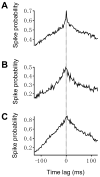Inspiratory-phase short time scale synchrony in the brainstem slice is generated downstream of the pre-Bötzinger complex
- PMID: 18455877
- PMCID: PMC2587425
- DOI: 10.1016/j.neuroscience.2008.02.034
Inspiratory-phase short time scale synchrony in the brainstem slice is generated downstream of the pre-Bötzinger complex
Abstract
Respiratory neurons are synchronized on a long time scale to generate inspiratory and expiratory-phase activities that are critical for respiration. Long time scale synchrony within the respiratory network occurs on a time scale of more than hundreds of milliseconds to seconds. During inspiration, neurons are synchronized on a short time scale to produce synchronous oscillations, which shape the pattern of inspiratory motor output. This latter form of synchrony within the respiratory network spans a shorter time range of tens of milliseconds. In the neonatal mouse rhythmically active medullary slice preparation, we recorded bilateral inspiratory activity from hypoglossal (XII) rootlets to study where in the slice synchronous oscillations are generated. Based on previous work that proposed the origin of these oscillations, we tested the pre-Bötzinger complex (PreBötC) and the XII motor nucleus. Unilateral excitation of the PreBötC, via local application of a perfusate containing high K(+), increased mean inspiratory burst frequency bilaterally (296+/-66%; n=10, P<0.01), but had no effect on the relative power of oscillations. In contrast, unilateral excitation of the XII nucleus increased both mean peak integrated activity bilaterally (ipsilateral: 41+/-10%, P<0.01; contralateral: 17+/-7%; P<0.05, n=10) and oscillation power in the ipsilateral (50+/-17%, n=7, P<0.05), but not in the contralateral rootlet. Cross-correlation analysis of control inspiratory activity recorded from the left and right XII rootlets produced cross-correlation histograms with significant peaks centered around a time lag of zero and showed no subsidiary harmonic peaks. Coherence analysis of left and right XII rootlet recordings demonstrated that oscillations are only weakly coherent. Together, the findings from local application experiments and cross-correlation and coherence analyses indicate that short time scale synchronous oscillations recorded in the slice are likely generated in or immediately upstream of the XII motor nucleus.
Figures







Similar articles
-
Cholinergic neurotransmission in the preBötzinger Complex modulates excitability of inspiratory neurons and regulates respiratory rhythm.Neuroscience. 2005;130(4):1069-81. doi: 10.1016/j.neuroscience.2004.10.028. Neuroscience. 2005. PMID: 15653001 Free PMC article.
-
Generation and transmission of respiratory oscillations in medullary slices: role of excitatory amino acids.J Neurophysiol. 1993 Oct;70(4):1497-515. doi: 10.1152/jn.1993.70.4.1497. J Neurophysiol. 1993. PMID: 8283211
-
Functional Interactions between Mammalian Respiratory Rhythmogenic and Premotor Circuitry.J Neurosci. 2016 Jul 6;36(27):7223-33. doi: 10.1523/JNEUROSCI.0296-16.2016. J Neurosci. 2016. PMID: 27383596 Free PMC article.
-
Synaptic control of motoneuron excitability in rodents: from months to milliseconds.Clin Exp Pharmacol Physiol. 2000 Jan-Feb;27(1-2):120-5. doi: 10.1046/j.1440-1681.2000.03202.x. Clin Exp Pharmacol Physiol. 2000. PMID: 10696540 Review.
-
Neuronal mechanisms of respiratory rhythm generation: an approach using in vitro preparation.Jpn J Physiol. 1997 Oct;47(5):385-403. doi: 10.2170/jjphysiol.47.385. Jpn J Physiol. 1997. PMID: 9504127 Review.
Cited by
-
Asymmetric control of inspiratory and expiratory phases by excitability in the respiratory network of neonatal mice in vitro.J Physiol. 2009 Mar 15;587(Pt 6):1217-31. doi: 10.1113/jphysiol.2008.164079. Epub 2009 Jan 26. J Physiol. 2009. PMID: 19171658 Free PMC article.
-
Central and peripheral factors contributing to obstructive sleep apneas.Respir Physiol Neurobiol. 2013 Nov 1;189(2):344-53. doi: 10.1016/j.resp.2013.06.004. Epub 2013 Jun 11. Respir Physiol Neurobiol. 2013. PMID: 23770311 Free PMC article. Review.
-
GAD67-GFP+ neurons in the Nucleus of Roller. II. Subthreshold and firing resonance properties.J Neurophysiol. 2011 Jan;105(1):249-78. doi: 10.1152/jn.00492.2010. Epub 2010 Nov 3. J Neurophysiol. 2011. PMID: 21047931 Free PMC article.
-
Synchronization of presynaptic input to motor units of tongue, inspiratory intercostal, and diaphragm muscles.J Neurophysiol. 2011 May;105(5):2330-6. doi: 10.1152/jn.01078.2010. Epub 2011 Feb 9. J Neurophysiol. 2011. PMID: 21307319 Free PMC article.
-
GAD67-GFP+ neurons in the Nucleus of Roller: a possible source of inhibitory input to hypoglossal motoneurons. I. Morphology and firing properties.J Neurophysiol. 2011 Jan;105(1):235-48. doi: 10.1152/jn.00493.2010. Epub 2010 Nov 3. J Neurophysiol. 2011. PMID: 21047932 Free PMC article.
References
-
- Baker SN, Kilner JM, Pinches EM, Lemon RN. The role of synchrony and oscillations in the motor output. Exp Brain Res. 1999;128:109–117. - PubMed
-
- Bou-Flores C, Berger AJ. Gap junctions and inhibitory synapses modulate inspiratory motoneuron synchronization. J Neurophysiol. 2001;85:1543–1551. - PubMed
-
- Christakos CN, Cohen MI, Barnhardt R, Shaw CF. Fast rhythms in phrenic motoneuron and nerve discharges. J Neurophysiol. 1991;66:674–687. - PubMed
Publication types
MeSH terms
Substances
Grants and funding
LinkOut - more resources
Full Text Sources

